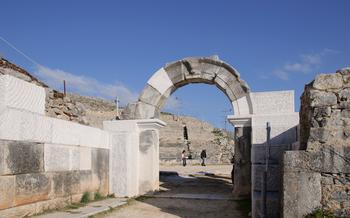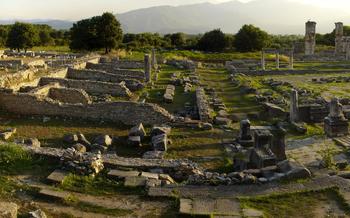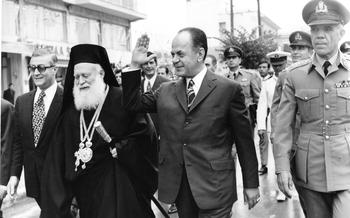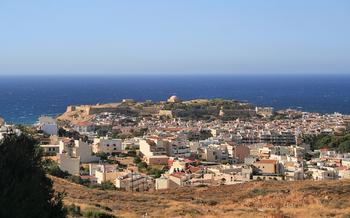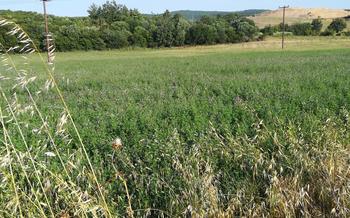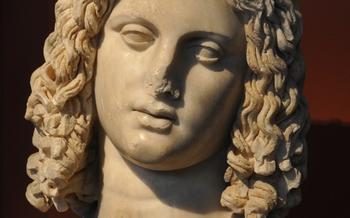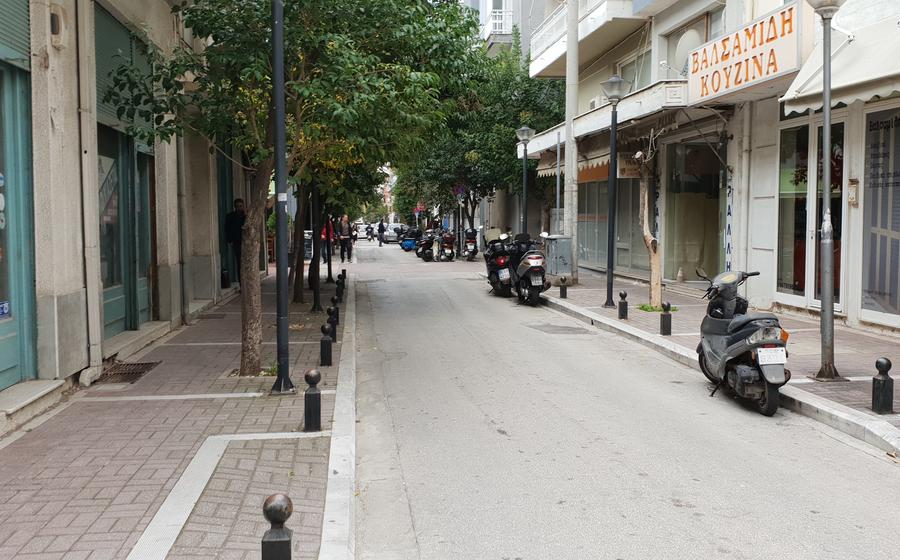
Archaeological Site of Traianoupolis
- History of Traianoupolis
- Location of Traianoupolis
- Fortifications and Walls
- Public Buildings
- Temples and Sanctuaries
- Residential Areas
- Aqueduct and Water Supply
- Mosaics and Artworks
- Necropolis and Burials:
- Traianoupolis Museum
- Visitor Center and Facilities
- Events and Festivals: A Journey Through Time
- Nearby Attractions:
- Insider Tip
History of Traianoupolis
Traianoupolis, a city founded by the Roman Emperor Trajan in 106 AD, holds significant historical value. It played a crucial role in the Roman Empire as a strategic military outpost and a prosperous trading center. The city's advantageous location at the crossroads of major trade routes facilitated the exchange of goods and ideas between the East and the West. Its strategic position allowed for control over the surrounding region and protected the empire's borders. The impressive architectural remains, including well-preserved fortifications, public buildings, and temples, provide a glimpse into the grandeur and sophistication of this ancient city.
Location of Traianoupolis
Traianoupolis is situated in northeastern Greece, in the region of Eastern Macedonia and Thrace. Its exact geographical coordinates are 40°50'40"N 25°52'10"E. The site is located approximately 15 kilometers southeast of the city of Alexandroupoli, making it an accessible day trip from the regional capital. Other major cities in proximity include Kavala (90 kilometers to the southwest) and Thessaloniki (200 kilometers to the west). Traianoupolis is easily accessible by road, with well-maintained highways connecting it to neighboring towns and cities. Visitors can conveniently reach the site by car or by organized tour buses from nearby destinations.
Fortifications and Walls
The city of Traianoupolis was surrounded by impressive fortifications, showcasing the military prowess and strategic thinking of its ancient inhabitants. The walls, constructed from massive stone blocks, stood tall and strong, providing impenetrable protection against potential invaders. Towers and gates were strategically positioned along the perimeter, allowing for vigilant surveillance and controlled access. These fortifications not only served as a defensive barrier but also reflected the city's wealth and importance as a thriving hub of trade and commerce. The strategic placement of Traianoupolis on a hilltop further enhanced its defensive capabilities, making it a formidable force to be reckoned with in ancient times.
Public Buildings
Among the excavated remains of Traianoupolis, the public buildings hold significant importance in understanding the civic and administrative aspects of the ancient city. These structures served various functions and played a crucial role in the daily life of its inhabitants.
One of the most notable public buildings is the agora, the central marketplace and gathering place. It consisted of an open courtyard surrounded by shops, stoas (covered walkways), and other commercial establishments. Here, citizens engaged in trade, exchanged goods, and conducted business transactions.
Another significant public building is the bouleuterion, the council chamber where the city's governing body, the boule, met to discuss and make decisions on civic matters. This impressive structure featured rows of stone benches arranged in a semicircular fashion, allowing the boule members to convene and deliberate on issues affecting the city.
Other public buildings include the gymnasium, a complex dedicated to physical education and training, and the theater, a venue for entertainment and cultural performances. The gymnasium comprised various facilities such as a palestra (wrestling arena), a running track, and bathing facilities. The theater, with its well-preserved seating tiers, provided a space for citizens to enjoy theatrical productions, musical performances, and other spectacles.
These public buildings not only served practical purposes but also showcased the architectural prowess and artistic sensibilities of the ancient Traianoupolitans. Their grandeur and intricate designs reflect the city's prosperity and the importance it placed on civic life, trade, and cultural pursuits.
Temples and Sanctuaries
Within the sacred precincts of Traianoupolis, gods and goddesses were venerated in grand temples and sanctuaries. These religious edifices, adorned with intricate architectural details, served as focal points for the spiritual and communal life of the city's inhabitants.
The Temple of Apollo, with its imposing columns and finely carved pediments, stood as a testament to the profound devotion accorded to the sun god. Within its hallowed halls, supplicants sought divine guidance and offered prayers for blessings and protection. The sanctuary of Asclepius, god of healing, attracted pilgrims from far and wide, seeking solace and remedy for their ailments.
Excavations have unearthed an array of votive offerings and cult objects, revealing the diverse deities worshipped in Traianoupolis. Statues, altars, and inscriptions provide glimpses into the religious beliefs and practices of the ancient city's inhabitants. These artifacts offer valuable insights into the spiritual fabric of Traianoupolis and its deep connection to the divine realm.
Residential Areas
The residential quarters of Traianoupolis offer a glimpse into the daily lives of its ancient inhabitants. The city was divided into distinct neighborhoods, each with its own unique character. The houses varied in size and design, reflecting the social and economic status of their occupants.
The majority of the population lived in modest dwellings, typically consisting of a single room with a central hearth for cooking and heating. These homes were often built using local materials such as stone, wood, and mud bricks. The floors were usually made of packed earth or simple tiles.
Wealthier residents enjoyed more spacious and elaborate homes, featuring multiple rooms, courtyards, and even private baths. These houses were often decorated with colorful mosaics and frescoes, depicting scenes from mythology or everyday life.
The residential areas were bustling hubs of activity, where people went about their daily tasks. Women were responsible for cooking, cleaning, and raising the children. Men worked in the fields, engaged in trade, or served in the military. Children played in the streets or attended school, where they learned reading, writing, and arithmetic.
The social structure of Traianoupolis was complex and hierarchical. At the top were the wealthy landowners and merchants, followed by the skilled craftsmen and artisans. The majority of the population consisted of farmers, laborers, and slaves.
Aqueduct and Water Supply
The ancient city of Traianoupolis boasted an impressive aqueduct system that supplied water to its inhabitants. This engineering marvel was crucial for sustaining life and supporting the city's growth and development. The aqueduct channeled water from distant sources, traversing hills and valleys to reach the city. The water flowed through underground pipes and elevated channels, demonstrating the advanced hydraulic knowledge of the ancient builders. The aqueduct's construction ensured a steady supply of clean water for domestic use, public fountains, and baths, contributing to the city's sanitation and overall well-being. This remarkable feat of engineering stands as a testament to the ingenuity and resourcefulness of the ancient Traianoupolitans.
Mosaics and Artworks
Traianoupolis boasts an impressive collection of exquisitely preserved mosaics and artworks that offer a glimpse into the city's artistic prowess and cultural heritage. Adorn the floors and walls of public buildings, temples, and private residences, these mosaics showcase intricate designs, vibrant colors, and a variety of themes and motifs.
The mosaics depict scenes from mythology, daily life, nature, and geometric patterns. They feature gods and goddesses, mythical creatures, hunting expeditions, agricultural activities, and everyday objects. The level of detail and craftsmanship is remarkable, with each tile carefully placed to create lifelike and captivating compositions.
The artistic influences in these mosaics are diverse, ranging from Greek and Roman styles to Eastern and local traditions. Hellenistic and Roman mythology are prominent themes, as seen in representations of Zeus, Aphrodite, Dionysus, and other deities. The mosaics also incorporate elements of local Thracian culture, such as scenes of horse riding and hunting, reflecting the region's unique identity.
These artworks provide valuable insights into the culture, beliefs, and daily life of ancient Traianoupolis. They not only beautified the city's buildings but also served as a form of storytelling and education, conveying messages and narratives to the inhabitants. The mosaics are a testament to the city's artistic achievements and continue to inspire and captivate visitors to this day.
Necropolis and Burials:
The ancient city of Traianoupolis had multiple burial sites, offering insights into the funerary practices and beliefs of its inhabitants. These necropolises were typically located outside the city walls, demonstrating the separation between the living and the dead. The most notable burial ground is the East Necropolis, situated about 500 meters from the city's eastern gate. Here, archaeologists have unearthed a variety of tombs, including both individual and family graves. The tombs exhibit diverse architectural styles, ranging from simple pit graves to elaborate chamber tombs. Within these tombs, researchers have discovered a wealth of grave goods, such as pottery vessels, jewelry, coins, and personal items. These objects provide clues about the social status, wealth, and beliefs of the deceased. The study of burial practices at Traianoupolis sheds light on the religious beliefs and conceptions of the afterlife held by the ancient Thracians and Romans who inhabited this remarkable city.
Traianoupolis Museum
The Traianoupolis Museum, located within walking distance of the archaeological site, is a must-visit for anyone interested in delving deeper into the history and culture of ancient Traianoupolis. This modern and well-curated museum houses a comprehensive collection of artifacts unearthed during excavations. Visitors can admire intricate mosaics, pottery, sculptures, coins, and other relics that provide a glimpse into the daily lives, religious practices, and artistic traditions of the city's inhabitants. Interactive displays and educational resources bring the past to life, making the museum an ideal place for families and history enthusiasts alike. The museum's knowledgeable staff is on hand to answer questions and provide guided tours, enhancing the overall visitor experience.
Visitor Center and Facilities
A modern visitor center is located near the entrance of the archaeological site, providing essential services and facilities for a comfortable and informative experience. Knowledgeable staff is on hand to assist visitors with inquiries, offer guided tours, and distribute maps and brochures. The center houses a small museum showcasing artifacts discovered during excavations, including pottery, coins, and sculptures, offering a glimpse into the daily life and culture of ancient Traianoupolis.
Accessibility is a priority at the site, with wheelchair ramps and accessible pathways ensuring that visitors with disabilities can navigate the grounds and enjoy the exhibits. Restrooms and parking are available on-site, providing convenience and comfort for all visitors. These facilities enhance the overall visitor experience, making Traianoupolis accessible and enjoyable for people of all abilities.
Events and Festivals: A Journey Through Time
Traianoupolis comes alive during cultural events and festivals, offering visitors a chance to immerse themselves in the ancient world. Reenactments, performances, and exhibitions bring the history of the city to life, showcasing the daily lives, traditions, and rituals of its inhabitants. These events provide an engaging and interactive way to experience the rich cultural heritage of Traianoupolis.
The "Traianoupolis Festival" is a highlight, held annually during the summer months. It features theatrical performances, music concerts, and craft demonstrations, all set against the backdrop of the ancient ruins. Visitors can witness gladiatorial battles, learn about traditional crafts, and savor delicious local cuisine.
For those interested in a more in-depth exploration, guided tours led by experienced historians and archaeologists are available throughout the year. These tours offer insights into the city's architecture, history, and significance, providing a deeper understanding of its role in the ancient world.
Nearby Attractions:
Beyond the captivating ruins of Traianoupolis, the surrounding region offers a wealth of attractions for history buffs and nature enthusiasts alike. Just a short drive away, visitors can explore the ancient city of Philippi, where the famous Battle of Philippi took place in 42 BC. The site boasts well-preserved ruins, including a theater, a forum, and a basilica, offering a glimpse into the grandeur of the Roman Empire.
For those seeking natural wonders, the region is home to stunning landscapes and pristine beaches. The Nestos River Delta, a protected wetland area, is a haven for birdwatchers and nature lovers, with its diverse flora and fauna. Visitors can embark on boat tours or hiking trails to explore this unique ecosystem.
The nearby town of Alexandroupoli, the capital of the region, offers a vibrant cultural scene, with museums, art galleries, and lively nightlife. Don't miss the opportunity to savor the region's culinary delights, including fresh seafood, traditional Greek dishes, and delectable local wines.
Insider Tip: For an unforgettable experience, plan your visit to coincide with one of the many cultural events and festivals held in the region. From traditional dance performances to historical reenactments, these events offer a chance to immerse yourself in the rich heritage of Greece.
Insider Tip
If you're a history enthusiast and want to avoid the crowds, plan your visit to Traianoupolis during the shoulder seasons (spring or autumn) or on weekdays to enjoy a more tranquil ambiance.
Unveil the hidden gems of the site by venturing off the beaten path. Explore the lesser-known corners of the city, such as the Odeon (a small theater), the Gymnasium (an athletic training facility), or the Agora (the marketplace), to gain a deeper understanding of daily life in ancient Traianoupolis.
Capture the essence of Traianoupolis through photography. The golden hour, around sunrise or sunset, casts a warm glow on the ruins, creating stunning photo opportunities. Experiment with different angles and perspectives to capture the grandeur of the site.
For an immersive experience, consider booking a guided tour. Knowledgeable guides can provide insights into the history, architecture, and significance of Traianoupolis, bringing the ancient city to life.
